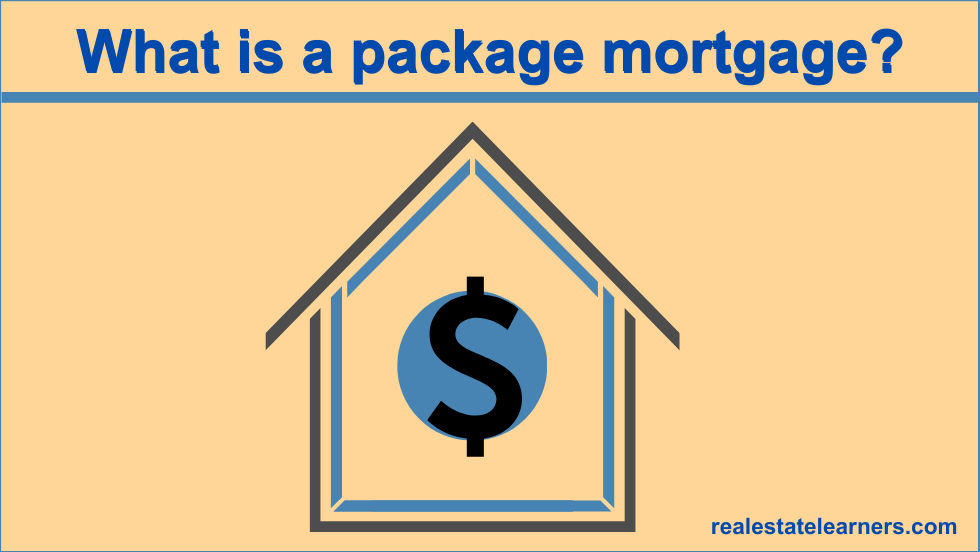When it comes to real estate transactions, there are various types of mortgages that can be used to finance a property purchase. Two common options are package and blanket mortgages. These two terms may sound similar, but they actually refer to distinct types of mortgage loans.
In this article, we will explore the differences between package and blanket mortgages and how each type may be beneficial for different real estate scenarios.
What is a package mortgage in real estate?
A package mortgage is a type of home loan that combines the financing for real estate properties with other personal assets. It involves bundling multiple assets, such as a primary residence and investments, together to secure a larger loan amount from a lender.
This type of mortgage is commonly used by high net worth individuals or investors who want to leverage their assets for buying additional properties or making other large purchases.
What is the Example of Package Mortgage?
Example 1- A couple wants to purchase a vacation home that costs $500,000. It has some personal assets such as furniture, artwork, and other appliances that costs around $100,000. By taking out a package mortgage, they can combine the financing for the vacation home and their personal assets to secure a larger loan amount from a lender.
Example 2: A business owner wants to purchase a commercial property for $2 million. They have personal assets worth $1 million, including investments, cars, and equipment. Instead of taking out a traditional mortgage, they can opt for a package mortgage to combine the financing for the commercial property with their assets.
Example 3: An investor wants to expand their real estate portfolio by purchasing multiple rental properties. They have a primary residence worth $1 million and investments worth $500,000. With a package mortgage, they can use their assets to secure a larger loan amount and purchase more properties.
Example 4: A family wants to buy a new home that costs $800,000, but they also have other personal assets, such as a boat and rental properties worth $200,000. Instead of selling their assets to fund the down payment for the new home, they can use a package mortgage to combine their financing and keep their assets intact.
Example 5: A retiree wants to purchase a second home in a retirement community that costs $400,000 but only has $200,000 in cash savings. They also have a primary residence worth $500,000 and investments worth $300,000. With a package mortgage, they can use their assets to secure the remaining funds needed for the second home without depleting their savings.
These are just some examples of how package mortgages can be beneficial and versatile in real estate financing.
What is a package loan?
A package loan is similar to a package mortgage but not limited to real estate properties. It can also include other assets such as cars, boats, and investments. This type of loan allows borrowers to use their various assets as collateral for a larger loan amount.
Package loans are commonly used by businesses or individuals with high net worth who want to finance large purchases or investments without liquidating their assets.
What is a blanket mortgage in real estate?
A blanket mortgage is a loan that allows a borrower to use multiple properties as collateral. It is commonly used in commercial real estate transactions, where an individual or company owns multiple properties and wants to secure financing for all of them at once.
It can simplify the lending process by consolidating multiple loans into one. This can save time and paperwork for the borrower and potentially result in better terms or a larger loan amount.
What is the Example of Blanket Mortgage?
Example 1: A real estate development company wants to purchase a large plot of land for a new project but also needs additional funding for renovations on their current properties. They use a blanket mortgage to secure financing for both the land and renovations, using all their existing properties as collateral.
Example 2: An investor owns multiple rental properties and wants to expand their portfolio by purchasing another building. They use a blanket mortgage to secure funding for the new property and use their existing rental properties as collateral.
Example 3: A homeowner wants to build an addition to their current house but also needs funds for other personal expenses. They utilize a blanket mortgage by using their current home, vacation property, and investment account as collateral to secure financing for both projects.
Example 4: A company owns several commercial buildings and wants to purchase a new office space. They use a blanket mortgage to secure funding for the new property by using their existing buildings as collateral, allowing them to expand their business without selling their current assets.
Example 5: An individual wants to buy land in a desirable location to build their dream home but also needs funds for other investments. They utilize a blanket mortgage by using their current home, retirement account, and stock portfolio as collateral to secure financing for the land purchase and other investments.
What is the difference between Package and Blanket Mortgage?
Type of assets used as collateral: A package mortgage allows a borrower to use different types of personal assets, such as primary residences, investments, and personal belongings, as collateral. On the other hand, a blanket mortgage only uses real estate properties as collateral.
Purpose of financing: A package mortgage is typically used to secure funding for one purchase or investment. In contrast, a blanket mortgage is used to secure financing for multiple properties or projects.
Number of loans: A package mortgage combines all the assets into one loan, while a blanket mortgage can cover multiple properties but may still involve separate loans for each property.
Borrower qualifications: Package mortgages are often used by high-net-worth individuals with various personal assets. B blanket mortgages are more commonly used by businesses or investors who own multiple properties.
Lending terms: Package mortgages may have more flexible lending terms because they involve a variety of assets. On the other hand, blanket mortgages typically have stricter terms since they only use real estate as collateral.
What are the Advantages and Disadvantages of Packet Mortgage?
Advantages:
Flexibility: Package mortgages offer flexibility regarding the assets that can be used as collateral, allowing borrowers to secure larger loan amounts or better terms.
Simplified process: Combining multiple loans into one can save time and paperwork for the borrower.
Preservation of personal assets: Instead of selling personal assets to fund purchases, package mortgages allow borrowers to keep their assets intact.
Potential for better terms: With a larger loan amount and varied collateral, borrowers may be able to negotiate more favorable lending terms.
Versatility: Package mortgages can be used in various scenarios and for different financing needs.
Disadvantages:
High net worth requirement: Package mortgages often require borrowers to have high net worth and diverse assets, making them less accessible for the average borrower.
Higher risk for borrowers: Combining multiple loans into one can increase the risk for borrowers as they may be putting more assets at stake.
Potential for higher interest rates: With the added flexibility and versatility, package mortgages may come with higher interest rates than traditional mortgages.
Complicated terms: Package mortgages can involve complex terms and conditions due to the variety of assets involved, making it important for borrowers to thoroughly understand the terms before agreeing to the loan.
Limited options: Not all lenders offer package mortgages, limiting borrowers’ options regarding financing strategies.
What are the Advantages and Disadvantages of Blanket Mortgage?
Advantages:
Simplifies financing process: Using one loan for multiple properties can save time and paperwork for the borrower.
Cost-effective: Instead of paying separate closing costs and fees for each property, a blanket mortgage only involves one set of fees.
Potential for better terms: With multiple properties as collateral, borrowers may be able to negotiate more favorable lending terms.
Helps with portfolio diversification: Blanket mortgages allow investors to expand their real estate portfolio without tying up all their assets in one property.
Versatility: Blanket mortgages can be used for various financing needs and scenarios like package mortgages.
Disadvantages:
Limited options for collateral: Only real estate properties can be used as collateral for a blanket mortgage, limiting the borrower’s options.
High risk for borrowers: Combining multiple properties into one loan increases the risk for borrowers as they may be putting more assets at stake.
Potential for higher interest rates: With multiple properties involved and potential risk for the lender, blanket mortgages may come with higher interest rates.
Qualification requirements: Borrowers must have a good credit score and significant property equity to qualify for a blanket mortgage.
Potential for cross-default: If one property defaults on the loan, it may affect the other properties tied to the blanket mortgage, potentially resulting in the foreclosure of all properties.
Conclusion
Package mortgage real estate definition is a financing option that allows borrowers to use various personal assets as collateral for one loan. On the other hand, blanket mortgages only use real estate properties as collateral and can cover multiple properties or projects.
Both types of mortgages have advantages and disadvantages, making it essential for borrowers to carefully consider their options before deciding which type best suits their needs.
However, they can be useful for high-net-worth individuals and businesses seeking funding for various investments or property purchases. It is crucial for borrowers to thoroughly understand the terms and risks involved in either type of mortgage before making a decision.

Corey has over 15 years of experience as a real estate broker and educator. He is dedicated to providing valuable insights and guidance for those looking to enter the real estate industry.

